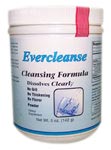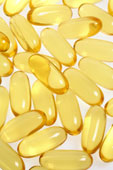
Recent Blog Posts
April 21, 2009
Is spackled waste making you fat?
“Oh, no! Not again…” This is what I find myself saying every time I hear a commercial for a weight loss product called Ever Cleanse — which unfortunately seems air every time I turn on the radio. In case you’ve somehow missed it, the ad copy goes something like this (I’ll insert my own comments in parentheses):

“Guys, we eat too much red meat, fast foods and processed foods. This keeps the belly flabby and keeps our bodies overweight”
(Probably the only statement in the commercial that has any credence. They should have quit while they were ahead.)
“Ladies, have you ever said ‘I feel fat today!’?”
(A clear attempt at tapping into a woman’s emotions. After all, is there any woman on the planet who hasn’t uttered these words at one time or another. But the hype is just beginning…)
“And how many of you have been trying to shed the same 10 to 20 pounds for years?”
(Another blatant emotional ploy. By now they’ve no doubt got the attention of virtually every listener. Mission accomplished.)
“There’s a healthy and faster way to lose weight!”
(Really? Faster than what? And for the record, ‘healthy’ weight loss doesn’t come fast. To lose a pound of fat you need to create a caloric deficit of about 3500 calories–count them up and see that you’re lucky to lose two pounds a week of body fat under the best of conditions.)
“It’s called Ever Cleanse; a clinically proven weight loss and detox formula that helps you lose weight and get rid of the 10 to 25 pounds of waste that some experts say is trapped to the colon walls like spackle or paste.”
(Whoa! Clinically proven? Where’s the clinical proof? Not a shred of evidence is cited in the commercial as to the product’s efficacy. For the record, I did a search on Medline and couldn’t locate a single peer-reviewed study that investigated Ever Cleanse in any capacity. Moreover, who are these experts that say we have spackled waste clinging to our colon? The only “experts” that I can imagine making such claims would be marketing experts who hawk products purported to reduce colon waste.)
“Two weeks of Evercleanse may be equal to months of dieting. It’s simple too. Natural, tasteless crystals dissolve in any food.”
(Gee, and here I’ve spent the better part of my life studying the science of exercise and nutrition and the answer to weight loss is actually as simple as sprinkling some tasteless crystals into my Big Mac and Fries. Whoopee, I can stop sweating and go back to being a couch potato!)
“Evercleanse will flatten out your midsection, reduce love handles; bellies and bloating have been disappearing in just days.”
(Say what? No more love handles? Bellies disappearing in days? Are they kidding? In case the ad copy writers played hooky during high school physiology, ‘love handles’ are, by defintion, the result of a buildup of excess body fat–not colonic waste. And while it’s possible that some people may have impacted colonic fecal matter, this certainly isn’t what is making them fat. Go back to the first line of the ad: the problem in today’s society is that people tend to eat too much and don’t exercise enough. Plain and simple.).
The ad spirals further downhill from here, making increasingly outrageous statements about the benefits of Ever Cleanse, but I’m sure you get the point. While I wish I could just dismiss it as a bad joke, the sad fact is that every day thousands of people buy into the hype and plunk down their hard earned money for worthless weight loss products. Consumers have been led to believe that if a product is advertised in the media then the claims made must be true. Wrong! Fact: The supplement industry is pretty much completely unregulated. That means any company claim virtually whatever they want without fear of retribution. And that means buyer beware.
Bottom line: Forget the weight loss shortcuts. Save your money and realize there are no secret formulas out there that magically melt away the pounds. If you want to maintain a healthy, fit body, you need to eat properly and exercise. No two ways about it. Fortunately, if you adhere to a fitness lifestyle, you’ll look great into your golden years and enjoy a better quality of life. And that’s no hype.
Stay Fit!
Brad
June 16, 2008
Demystifying Omega-3 Fats
What’s the world’s most perfect food source? A good case can be made that it’s wild-caught cold-water fish such as salmon, mackerel, and trout. Not only are these fish high in quality protein, but they are replete in omega-3 fats. What’s so special about omega-3’s? Well, first off they are essential nutrients, meaning 1) they cannot be manufactured in the body and 2) they are required to avoid disease.
The bene fits of consuming adequate omega-3’ fats are numerous. They help to improve cell signaling, enhance skin, hair and nails, and regulate important hormone-like compounds called eicosanoids. Perhaps their most important health-related function is their positive effect on the cardiovascular system. Not only do they inhibit the production of LDL (the “bad” form of cholesterol that has been implicated in the formation of atherosclerotic plaques), but they increase the output of HDL (the “good” cholesterol). This explains why replacing saturated fats with omega-3s on a calorie-for-calorie basis has been shown to reduce the risk of cardiovascular mortality by as much as 70 percent.
fits of consuming adequate omega-3’ fats are numerous. They help to improve cell signaling, enhance skin, hair and nails, and regulate important hormone-like compounds called eicosanoids. Perhaps their most important health-related function is their positive effect on the cardiovascular system. Not only do they inhibit the production of LDL (the “bad” form of cholesterol that has been implicated in the formation of atherosclerotic plaques), but they increase the output of HDL (the “good” cholesterol). This explains why replacing saturated fats with omega-3s on a calorie-for-calorie basis has been shown to reduce the risk of cardiovascular mortality by as much as 70 percent.
Omega-3 fats are also extremely important from a body composition standpoint. Because of their utility on cells, the body prefers to use Omega-3’s to fuel cellular functions and won’t store them as fat until these functions are satisfied. Specifically, they act as fuel partitioners, directing fatty acids away from storage and towards oxidation. One of the ways this is accomplished is through enzyme regulation, increasing the activity of fat burning enzymes and suppressing the activity of fat storing enzymes. The net effect is better fat metabolism and hence an improved body composition.
Additionally, Omega-3’s increase levels of a class of fat burning compounds called uncoupling proteins (UCPs). UCPs act on various bodily tissues to heighten thermogenesis, allowing calories to be burned off immediately as heat rather than stored as fat. Unfortunately, these substances are inhibited in many people, especially in those who are overweight. By revving up UCP activity, Omega 3’s shift your body into a fat burning mode, promoting a leaner physique.
In addition to cold water fish, omega-3’s can be found in high amounts in flax oil—the prime choice for vegetarians. Soy, walnuts, and hemp oil also contain modest amounts of omega-3 fats. Most people, however, do not take in enough of these food sources to satisfy omega-3 requirements. Worse, they consume an abundance of omega-6 fats which compete with omega-3’s for desaturation as well as producing pro-inflammatory eicosanoids that, unless counterbalanced by anti-inflammatory eicosanoids produced by omega-3’s, can result in a plethora of health issues.
If you’r e not getting enough omega-3’s, it may be beneficial to consume fish oil supplements. They come in capsule form (usually gel caps) and should be taken at mealtime. Although no specific guidelines have been set on for intake, a general guideline is to consume one gram for every 25 pounds of bodyweight (each capsule is usually one gram). It’s generally best to consume half the dose in the morning and the other half at night.
e not getting enough omega-3’s, it may be beneficial to consume fish oil supplements. They come in capsule form (usually gel caps) and should be taken at mealtime. Although no specific guidelines have been set on for intake, a general guideline is to consume one gram for every 25 pounds of bodyweight (each capsule is usually one gram). It’s generally best to consume half the dose in the morning and the other half at night.
Remember, though, that omega-3’s—like all dietary fats—are calorically dense. In order to realize positive changes in body composition, you need to make sure that total caloric intake is within your metabolic range. Calories do count and you can’t lose body fat if intake is greater than expenditure. What’s more, high doses of omega-3’s can potentially increase bleeding time. Check with your physician if any concerns exist.
Stay Fit!
Brad
TAGS: omega-3, omega-6, omega fats, fish oil, flaxseed oil, flax oil, UCP, uncoupling proteins, thermogenesis, eicosanoids
March 28, 2008
Food Combining Mumbo Jumbo
 “Don’t eat protein and carbs together!”
“Don’t eat protein and carbs together!”
If you believe the advice of certain “food combining” nutritionists, this apparently is the key to successful weight loss and better health. Standard food combining protocol consists of fruit in the morning, fruit and a salad for lunch, vegetables and either a starch or protein food for dinner, and fruit again for a late-night snack. No egg whites and oatmeal. No turkey breast on multi-grain bread. No beans of any kind!
Although the genesis of food combining can be traced back to the 19th century, its most prominent modern-day promoter was a man named Dr. Herbert Shelton. In recent years, Harvey Diamond, Susanne Somers and Marilu Henner have each popularized Shelton’s views in best-selling books, bringing food combining into the mainstream.
The central premise behind food combining is that nutrition is more a function of when and how you eat rather than what or how much you eat. This is based on the idea that digestion of protein and carbs require different pH levels: Protein thrives in an acidic environment while carbs require a more alkaline milieu. According to food combining proponents, eating these foods at the same time neutralizes stomach acids and therefore prevents proper nutrient assimilation. Without a means to be metabolized, the nutrients simply putrefy and rot in the stomach. Over time, there is a buildup of toxic waste material (called toxemia) which ultimately causes the body to store excess fat.
Truth is, however, food combining has no scientific basis. None! Zero! Nada! There isn’t a shred of evidence that any negative complications are directly attributable to eating protein and carbs in the same meal. In fact, it has repeatedly been shown in clinically controlled studies that mixed diets are actually an excellent means to improve health and sustain weight loss.
The premise of food combining is, in itself, faulty. The genius who came up with the theory apparently based it on the fact that the digestion of carbohydrate begins in the mouth—which is a basic environment—before undergoing further metabolism in the gut. One little flaw with the reasoning: The gut is always acidic, regardless of whether protein is consumed with carbs or not. In reality, carbs have no problem being fully digested in the gut, with or without protein.
But let’s throw physiology out the window for a moment and give the pH theory credence. Even if this were the case, the incomplete breakdown of carbs still wouldn’t result in toxemia. Nutrients can’t rot in the stomach, plain and simple. Once ingested, they are either assimilated or eliminated. Whatever your body can’t digest passes through to the colon and is excreted in the feces. Except for constipation, there simply is no mechanism by which food can remain in your system in a degraded form for an extended period of time. And if constipation is a problem, the likely cause is a lack of dietary fiber, not food combining.
Along the same lines, toxic waste cannot turn into fat—it’s a physiologic impossibility. In order for foods to be stored as fat, they must be first broken down and then converted into triglycerides. If a food is left undigested, it can’t be absorbed—period. And if a food can’t be absorbed, then it can’t be metabolized into a triglyceride (or anything else, for that matter).
Not convinced? Well, consider the typical bodybuilding diet. In their pre-competition phase, bodybuilders often subsist on nothing but chicken and rice (eaten at the same time). According to food combining proponents, these athletes should be packing on the pounds. Instead, they manage to attain body fat percentages as low as four percent—so much for the combination of protein and carbs causing fat storage!
There are practical reasons why it’s actually beneficial to consume protein and carbs together. Food combining is energetically wasteful. When you eat only one or two large protein-based meals a day, there is a tendency for the body to utilize protein for energy, rather than tissue-building purposes. Conversely, frequent consumption of protein provides the body with a steady source of amino acids. In fact, studies have shown muscular growth is about 20 percent greater when protein is consumed on a frequent basis as opposed to a twice-daily basis.
In final analysis, food combining is nothing more than another gimmick diet that uses a shred of fact to make an outrageous conclusion. Throughout history, humans have eaten an endless combination of foods without ill effect. Heck, the Japanese thrive on sushi and have amongst the lowest rates of obesity and highest life-expectancy in the world. So don’t feel guilty about eating carbs and protein together. Focus on the quality and quantity of what you eat and you’ll ultimately keep your body lean and mean.
Stay Fit!
Brad
TAGS: food combining, protein and carbs together, Suzanne Somers, Marilu Henner, Herbert Shelton, Harvey Diamond





 Entries (RSS)
Entries (RSS)



